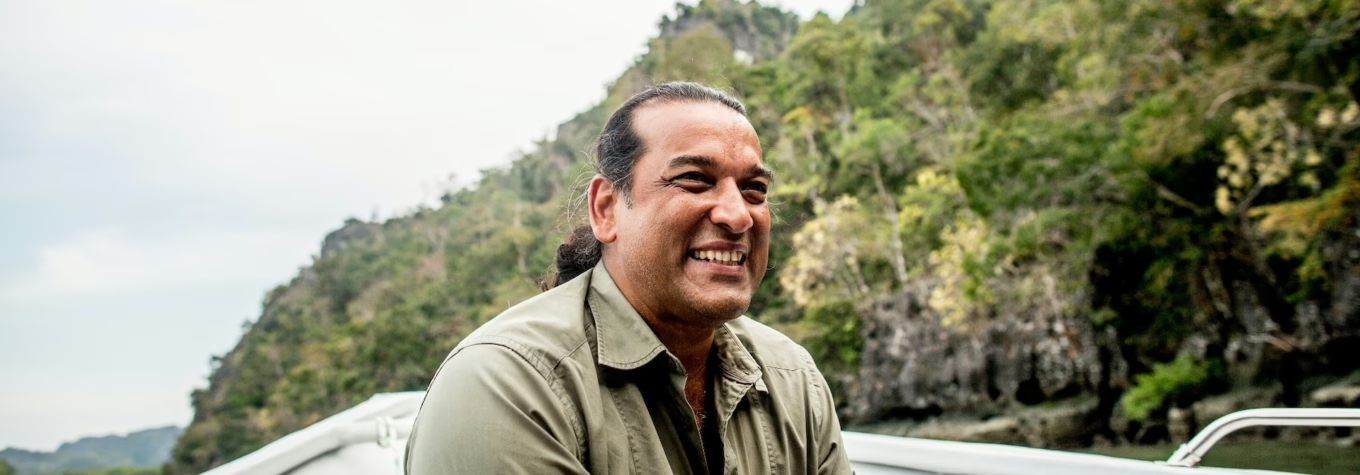Based in Langkawi for over 32 years, The Datai Langkawi’s resident nature guide says his life was changed upon encountering the island’s majestic sandstone cliffs and diversity of unique flora and fauna
In partnership with The Datai Langkawi
A celebrated nature conservationist in Malaysia and beyond, Irshad Mobarak gets his message out any way he can. Aside from appearing in nature documentaries, giving a TEDx Talk, authoring a book about Langkawi and winning Digi’s Amazing Malaysian Award in 2007, he is also the co-founder of tour operator JungleWalla and the resident naturalist at luxury eco-resort The Datai Langkawi.
Based in Langkawi for about 32 years, Irshad has dedicated his career to conserving the flora and fauna of Southeast Asia’s first Unesco Global Geopark. He was the first person in the country to spot and capture a recording of the elusive mountain hawk-eagle in Langkawi, alongside the late wildlife expert Miles Badeley.
Needless to say, Irshad is the best possible guide to help nature enthusiasts navigate Langkawi’s over 550 species of butterflies, 260 species of birds, 90 species of reptiles and about 50 species of mammals.
Here, we speak to the man himself about his body of work in conservation, how his role at The Datai Langkawi has evolved and what makes this Malaysian island worth a visit.

How did you get into nature conservation?
I come from a family that loves the outdoors and sports. On most school holidays, my father would bring the entire family to camp at a beach, stay in remote locations in the jungle or go trekking in search of waterfalls, durian and other wild fruits while visiting family friends at a small village town. My best memories are of playing, running, swimming and paddling in dugout canoes with Orang Asli kids at Tasik Bera in Pahang. So I was exposed to nature in all its glory at a very young age.
I remember, at the age of nine, while watching a nature documentary featuring my childhood hero, David Bellamy, my father asked me what I wanted to do when I grew up. I said, “I would like to be just like that man on TV, a wildlife ranger – that was what I thought he was – and I want to protect wildlife and nature”.

Was that what you did right after you graduated from school?
No, I became a banker at the age of 20, mostly because the company had a great rugby team, which I wanted to be a part of. Eventually, after four and a half years, I realised I had joined the industry for the wrong reasons. At the same time, I’d taken a trip to Tioman Island and was mesmerised by the beauty of the rainforest and the colours of the underwater world. I knew that I couldn’t continue sitting in an office, pushing paper. So I made the decision to leave the bank, bummed around for a couple of years, before finally coming to Langkawi and making it my home about 32 years ago.
What are some memorable highlights of your career as a naturalist?
I was able to travel to the Galapagos Islands in Ecuador, as well as Wallacea in Indonesia, visit the same sites that Charles Darwin and Alfred Russel Wallace, the co-founders of the theory of evolution, visited. To walk upon the very same beaches these legends had walked upon, take the same sea passages they took and see the same creatures they saw, albeit 150 years later, was a wonderful thing.

Tell us more about your role at The Datai Langkawi.
I have been with The Datai Langkawi for nearly 27 years and my role has evolved through the years. I’ve been leading nature walks with our guests since the very beginning. In the years that followed, I have curated many different nature experiences within The Datai Langkawi’s land bank, as well as several excursions that are a short drive away from the resort.
How have things changed since you first started?
We made the most changes to our nature offerings within the last four years, when Khazanah Nasional took over and placed The Datai Langkawi under Themed Attractions Resorts & Hotels’ management and general manager Arnaud Girodon’s leadership. Now, we have a team of two naturalists and two marine biologists, and a new Nature Centre. I now serve as the resort’s head naturalist and have expanded our offerings to include both land and marine-based activities. I have also travelled on behalf of The Datai Langkawi in search of potential sites in Malaysia to build a second resort.

What’s unique about the landscape and biodiversity of Langkawi?
Langkawi is well known for its stunning landscape and seascape, featuring sheer sandstone cliffs and sub-rounded limestone outcrops rising majestically out of the ocean. No other island in the region can compare to Langkawi’s rich geological history. A story that began nearly 550 million years ago, the island had witnessed some of the planet’s most significant geological events that saw a succession and diversity of rocks being laid down. This diversity of rocks determined the island’s diversity of flora, which in turn determined the island’s amazing diversity of fauna.
You can find several species of endemic plants and some special creatures that we like to call our fabulous, little flying five, namely, flying dracos – Latin for dragons – flying lemurs, flying foxes, flying squirrels and flying snakes, which are harmless I’d like to add.
To book a stay at The Datai Langkawi and take part in the variety of nature activities organised by resident naturalist Irshad Mobarak, contact the resort at +60 4 9500 500 or reservations@dataihotels.com. Residents of Malaysia and Singapore are also entitled to exclusive offers, more details of which can be found here.








